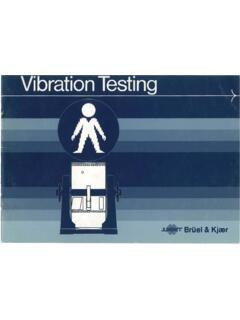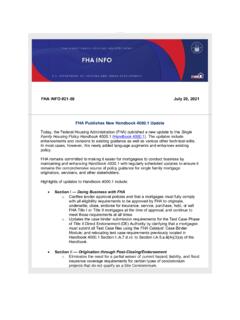Transcription of User Manual/Handbook: Microphone Handbook Volume 1 - …
1 Br el & Kj rBKBE 1447 12 TechnicalDocumentationWORLD HEADQUARTERS: DK-2850 N rum Denmark Telephone: +45 42 80 05 00 Telex: 37316 bruka dk Fax: +45 42 80 14 05 e-mail: Internet: HandbookVol. 1: TheoryMarch 2019BE 1447 12Br el & Kj rMicrophone HandbookVo l u m e 10 0Br el & Kj rMicrophone 2019, Br el & Kj r A/SAll rights reserved. No part of this publication may be reproduced or distributed in any form or by any means without prior consent in writing from Br el & Kj r Sound & Vibration Measurement A/S, N rum, 1447 120 iMicrophone Volume provides background information on the Br el & Kj r Microphone productrange. It gives an insight into the theory behind the development of microphones and pream-plifiers and explains the terminology used to describe these products.
2 The aim of this Volume is to promote a full understanding of measurement microphones andto provide sufficient background information for customers to get the best out of these prod-ucts. It also gives adequate information for customers to be able to make informed andqualified decisions about the Microphone products which are most suitable for their meas-urement requirements. These products are described in detail in more specific literature,such as Volume 2 of this Handbook and in product data sheets. Chapter 1 gives a brief history of Microphone development at Br el & Kj r and provides aninsight into the research and development invested in Microphone products. An overview ofthe production of microphones is also 2 gives a general introduction to Microphone theory and explains the decisions thatare made about the design and construction of 3 provides more detailed information about the characteristics of microphones withthe aim of allowing an informed view on the specifications applied to Microphone products.
3 Chapter 4 introduces the main characteristics of preamplifiers and explains the categories ofinformation given in Volume 2. Chapter 5 provides information on the selection criteria commonly used to identify the mostsuitable Microphone for different applications and also the most applicable accessories thatshould be used. Chapter 6 discusses the requirement for the calibration of microphones and offers an over-view of calibration methods. 0 iiBr el & Kj rMicrophone 1447 120 1 Contents1. 1 Background to Microphone Development at Br el & Kj 1 of Microphone 1 of Microphones at Br el & Kj 1 1 112. Microphone 2 Levels and Sound 2 2 Sound Field 2 2 Sound Pressure and Pressure 2 2 Particle Velocity and Particle Velocity 2 3 Sound Intensity and Sound Intensity 2 2 2 2 Microphone 2 Microphone 2 2 7 Design 2 7 Material and Process 2 9 Transduction 2 11 Diaphragm and Air 2 15 Static Pressure 2 16 Low Frequency Response and Vent 2 17 High Frequency 2 20 Microphone 2 24 Microphone Modelling by Equivalent Electric 2 25 Acoustic Impedance of Diaphragm 2 27 Equivalent Volume of the Diaphragm 2 of Microphone and 2 31 Microphone 2 31 Electrical Frequency Response of Microphone and 2 32 Inherent Noise of Microphone 2 2 Types Dedicated to Different
4 Sound 2 43 Influence of the Microphone on the 2 43 Microphone el & Kj r0 2 Contents Pressure Field Microphone and 2 45 Influence of Microphone on the Measured Sound Pressure in a 2 45 Free-Field Microphone and 2 48 Influence of the Microphone on the Measured Sound Pressure in a Diffuse 2 49 Diffuse Field Microphone and 2 Term Microphone 2 Actuator 2 2 54 Electrostatic 2 55 Electrostatic Calibration 2 55 Electrostatic Actuator 2 57 Actuator and Pressure-field 2 58 General Note on Actuator 2 2 593. Characteristics of 3 to 3 2 The Calibration Chart and 3 3 3 Open-circuit Sensitivity (So).. 3 3 Loaded Sensitivity (Sc).. 3 4 Correction-factors K and 3 3 5 Introduction and Optimised 3 5 Low Frequency 3 6 High Frequency 3 7 Electrostatic Actuator 3 7 Free-field 3 9 Random Incidence 3 9 Pressure-field 3 3 3 11 Inherent 3 11 Maximum Sound Pressure 3 Diaphragm 3 Calibrator Load 3 3 3 14 Externally Polarized 3 14 Prepolarized 3 3 3 3 17 Long-term 3 3 17 Short-term 3 17 Microphone 1447 120 3 18 Effect of 3 18 Effect of Ambient 3 19 Effect of 3 21 Effect of 3 21 Effect of Magnetic 3 21 Electromagnetic 3 214.
5 Characteristics of 4 to Characteristics of 4 2 Definition of a Microphone 4 2 Selection of a Microphone 4 2 Contents of this 4 4 2 Low Frequency 4 2 High Frequency 4 4 5 Upper limit of Dynamic 4 5 Maximum 4 6 Maximum 4 6 Maximum Slew 4 7 Lower Limit of Dynamic 4 4 of 4 of Magnetic 4 4 13 The European EMC 4 13 The CE 4 13 EMC Test Facilities at Br el & Kj 4 and Calibration 4 15 Insert Voltage 4 16 Charge Injection 4 17 CIC Input Signal 4 195. Selecting a 5 on Selecting 5 to 5 4 Frequency 5 4 Type of Sound 5 4 Limits of Dynamic 5 4 Microphone 5 5 Phase 5 5 5 Standards 5 5 7 Microphone el & Kj r0 4 Contents Microphone Array 5 The Right 5 8 Low Wind Speed, Random 5 9 High Wind Speed, Known 5 9 Turbulent Pressure 5 5 106.
6 6 6 of 6 6 6 5 Primary Calibration 6 6 Accredited Calibration 6 6 Calibration at the Br el & Kj r 6 Hierarchy, Traceability and 6 6 9 Reciprocity Calibration 6 10 Substitution 6 11 Comparison 6 11 Sound Pressure Calibrator 6 12 Actuator 6 12 Insert Voltage Calibration 6 13 Charge Injection Calibration 6 14 IndexMicrophone 1447 121 1 Chapter 1 IntroductionChapter 1 IntroductionHistorical Background to Microphone Development at Br el & Kj r Microphone el & Kj r1 Background to Microphone Development at Br el & Kj r Br el & Kj r began producing microphones in 1945. By the late 1950s they wereestablished as a leading supplier of measurement microphones, due largely to theinspirational leadership and enthusiasm of Dr.
7 Br el in the field of microphonedevelopment. In parallel, Br el & Kj r also conceived, designed and developed com-plete acoustic measurement systems. Measurement microphones formed an impor-tant part of these systems, in combination with instruments such as analysers,recorders and sound level meters. From this beginning, Br el & Kj r gained an increasingly good reputation amongstusers of microphones, both in the acoustics industry and in the field of academicresearch. This was achieved as a result of providing a high standard of service andreliable, well built products. The product range was also enhanced by a programmeof research and development that ensured continuous improvements in the accuracyand performance of new instruments.
8 Today, this approach continues to deliver in-novative measurement instrumentation, including a comprehensive range of meas-urement microphones in sizes from 1/8 to 1 . Together these microphones cover allaspects of measurement Microphone usage. By the early 1970s, Br el & Kj r s strong presence in the measurement microphonefield had become firmly established with the development of high sensitivity 1/2 microphones. These microphones benefited from new techniques allowing less ten-sion in the diaphragm, leading to an increase in sensitivity of approximately 12 this period Br el & Kj r also improved techniques to accurately measureand document the performance parameters of their measurement microphones andsupplied this information in the form of calibration charts.
9 Microphones could sub-sequently be relied upon according to certain stated parameters. of condenser measurement microphonesChapter 1 IntroductionHistorical Background to Microphone Development at Br el & Kj rMicrophone 1447 121 3 Calibration equipment was also made, such as reciprocity equipment for laboratorycalibration and the pioneering hand-held pistonphone. This convenient calibrationdevice effectively improved the accuracy of everyday Microphone usage by allowingusers to check measurement accuracy in the field. In 1973 Br el & Kj r consolidated their position as the leading Microphone produc-er by meeting a request from Western Electric to supply 1 microphones to replacetheir successful but ageing WE 640AA Microphone .
10 The Br el & Kj r solution tookthe form of the classic Type 4160 Microphone . The 4160 together with the 4180 (the1/2 version) were quickly established as reference microphones for laboratory stand-ard use, due mainly to their stability and accurately documented performance pa-rameters. Further innovations ensued, notably in improvements to electret processes duringthe 1970s, resulting in the production of stable prepolarised microphones whichbecame standard for use with sound level meters. The 1980s brought further devel-opments, in particular in the field of sound intensity measurement. The mid 1980salso saw the development of specialised types of probe Microphone . This microphonemade use of a revolutionary and now patented tube system which gives a flatFig.








